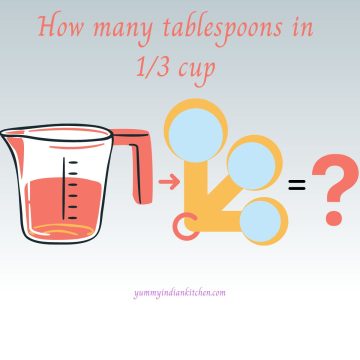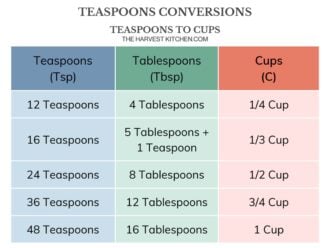Mastering Kitchen Conversions: How Many Tablespoons Are In 1/3 Of A Cup?
The Core Conversion: Unpacking 1/3 Cup to Tablespoons
At the heart of accurate cooking and baking lies a clear understanding of measurement equivalencies. When a recipe calls for 1/3 of a cup, and you're working with tablespoons, here's the definitive answer.The Simple Answer
To put it plainly, there are **5 and 1/3 tablespoons in 1/3 of a cup**. For practical purposes in your kitchen, this translates to: * **5 level tablespoons and 1 teaspoon.** This breakdown is incredibly helpful because most kitchens are equipped with standard measuring spoons for tablespoons and teaspoons. Knowing this exact conversion ensures that you can confidently measure out the correct amount, even if you don't have a 1/3 cup measuring cup available. Precision is particularly paramount in baking, where the balance of ingredients can significantly impact texture, flavor, and consistency.The Math Behind the Magic: Why 5 and 1/3?
To truly grasp this conversion, it's beneficial to understand the fundamental relationship between cups and tablespoons. The standard U.S. customary measurement dictates that: * **1 U.S. cup is equal to 16 tablespoons.** With this foundational knowledge, calculating how many tablespoons are in 1/3 of a cup becomes a simple division problem. You just need to determine one-third of 16 tablespoons: * **1/3 cup = 16 tablespoons ÷ 3** Performing this calculation gives us: * **16 ÷ 3 = 5.333... tablespoons** Now, what does "0.333..." mean in terms of practical measurement? This fractional part represents 1/3 of a tablespoon. And here's where another crucial conversion comes in handy: * **There are 3 teaspoons in 1 tablespoon.** Therefore, if 1/3 of a tablespoon is needed, it's equivalent to 1 teaspoon (since 1/3 of 3 teaspoons is 1 teaspoon). This explains why 5.333... tablespoons translates precisely to 5 tablespoons and 1 teaspoon. This fraction ensures you get as close to the exact measurement as possible, preventing any guesswork that could compromise your recipe.Beyond the Basics: Understanding Related Kitchen Conversions
Knowing how many tablespoons are in 1/3 of a cup is just one piece of the puzzle. A broader understanding of common kitchen conversions will empower you to tackle any recipe with ease.The Building Blocks: Teaspoons, Tablespoons, and Cups
These three units are the workhorses of most recipes. Remembering their relationships is key: * **3 teaspoons (tsp) = 1 tablespoon (tbsp)** * **16 tablespoons (tbsp) = 1 U.S. cup** These foundational conversions are the basis for almost all other liquid and dry ingredient measurements in standard U.S. recipes. For instance, if a recipe calls for 1/2 tablespoon, you instantly know that's 1 and 1/2 teaspoons.Other Common Cup Fractions in Tablespoons
While 1/3 cup is a common measurement, many recipes use other fractions. Here’s a quick reference for some of the most frequent conversions from cups to tablespoons: * **1/8 cup = 2 tablespoons** * **1/4 cup = 4 tablespoons** * **1/2 cup = 8 tablespoons** * **2/3 cup = 10 and 2/3 tablespoons (or 10 tablespoons + 2 teaspoons)** * **3/4 cup = 12 tablespoons** * **1 cup = 16 tablespoons** Having these conversions at your fingertips, whether memorized or readily accessible via a chart, can significantly speed up your cooking process and reduce errors.Special Considerations: Dry Ingredients and Butter
While the conversions generally apply to both liquid and dry ingredients, there are minor nuances. For instance, when a recipe instructs you to use "packed" brown sugar, you'll need to press it firmly into your measuring spoon or cup to ensure you get the correct density and amount. So, 5 packed tablespoons and 1 teaspoon of brown sugar will give you 1/3 cup. Butter is another ingredient that often requires precise measurement, and it's frequently measured in both cups and tablespoons. Good news: the conversion holds true for butter as well! * **1/3 cup of butter is equal to 5 and 1/3 tablespoons.** This consistency across various ingredient types makes these conversions incredibly versatile and useful for any home cook.Why This Conversion Matters in Your Kitchen
Beyond just knowing the numbers, understanding the practical application of these conversions is what truly makes you a better cook.Adjusting Recipes with Confidence
One of the most common reasons to know these conversions is when you need to adjust a recipe. Whether you're doubling a recipe for a crowd, halving it for a smaller meal, or simply trying to scale it up or down to fit your needs, having a grasp of these equivalencies is invaluable. * **Doubling:** If a recipe calls for 1/3 cup of an ingredient and you want to double it, you'd need 10 and 2/3 tablespoons (2 x 5 and 1/3 tbsp). * **Halving:** If you need to halve 1/3 cup, you'd be looking for 2 and 2/3 tablespoons (1/2 x 5 and 1/3 tbsp, which is 2 tablespoons plus 2 teaspoons). This ability to confidently adjust measurements prevents food waste and ensures your dish turns out as intended, regardless of the quantity.The Importance of Precision, Especially in Baking
Cooking often allows for a bit of improvisation and "eyeballing" ingredients. Baking, however, is much more like a science. The ratios of ingredients, especially dry ones like flour and leavening agents, are crucial for the chemical reactions that give baked goods their structure, texture, and rise. Even a slight inaccuracy in measuring flour or sugar can lead to a dry cake, flat cookies, or dense bread. Knowing that 1/3 cup is exactly 5 tablespoons and 1 teaspoon means you're providing your baked goods with the precise balance they need to achieve perfect results every time.When You Don't Have a Measuring Cup
Imagine you're halfway through a recipe and realize your 1/3 cup measuring cup is dirty, lost, or simply not part of your set. If you only have measuring spoons (tablespoons and teaspoons), knowing this conversion becomes your lifesaver. You won't have to pause your cooking, wash dishes, or guess—you can simply grab your spoons and continue with confidence. This practical knowledge empowers you to be resourceful and adaptable in the kitchen.Quick Reference: Your Handy Conversion Chart
To make things even easier, here's a concise breakdown of common cup-to-tablespoon conversions you can refer to: * **1 cup = 16 tablespoons** * **3/4 cup = 12 tablespoons** * **2/3 cup = 10 tablespoons + 2 teaspoons** * **1/2 cup = 8 tablespoons** * **1/3 cup = 5 tablespoons + 1 teaspoon** * **1/4 cup = 4 tablespoons** * **1/8 cup = 2 tablespoons** This chart, along with the fundamental knowledge that 1 tablespoon equals 3 teaspoons, covers the vast majority of measurement needs in home cooking and baking. Knowing how many tablespoons are in 1/3 of a cup is more than just a random piece of information; it's a fundamental skill that enhances your cooking and baking abilities. It empowers you to adjust recipes, ensures precision for perfect results, especially in baking, and provides a practical solution when specific measuring tools aren't available. Embrace these simple kitchen conversions, and you'll find yourself cooking and baking with greater confidence and success. *** **Final Summary:** In summary, 1/3 of a cup is equivalent to 5 and 1/3 tablespoons. This can be practically measured as 5 level tablespoons plus 1 teaspoon. This conversion is derived from the fact that there are 16 tablespoons in 1 U.S. cup, making 1/3 cup equal to 16 divided by 3, which is 5.33 tablespoons. Understanding this precise conversion is invaluable for accurate recipe adjustments, ensuring successful baking outcomes, and navigating your kitchen confidently even when specific measuring tools are unavailable.
How many tablespoons in 1/3 cup - Yummy Indian Kitchen

1 3 Cup in Tablespoons - Aubrie-has-Callahan

How Many Tablespoons in 1/3 Cup - The Harvest Kitchen